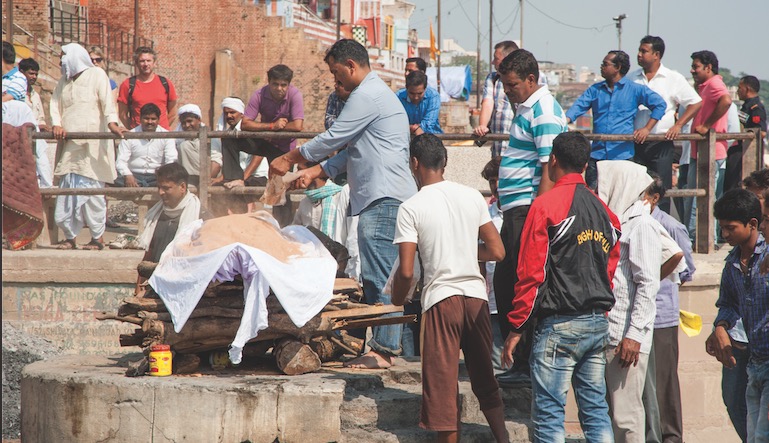Manikarnika Ghat: On this evening seven or eight cremations take place simultaneously as mourners watch
THE ANCIENT RHYTHM OF CREMATION
______________________
Mourners, priests and chandalas join to perform final rites for the departed
______________________
IN KASHI, EVEN PASSING A DEAD BODY ON its way to the cremation ghats—normally an inauspicious event—is considered a blessing. This odd receptivity to death stems from two related religious beliefs. One is that by dying in Kashi one automatically attains liberation from rebirth. The other is that liberation comes when Siva Himself personally gives the Tarak Mantra to those cremated here. These two convictions bring villagers from up to 200 km away to cremate their dead—and bring devotees from far and wide to die in Siva’s holy city.
In most places in India, cremation is not done after sunset; but here the main ghats—Manikarnika and Harishchandra—function around the clock, cremating up to a hundred bodies a day, and more in cold weather. In the photo at left, seven or eight cremation pyres are burning at once, and this is typical.
Day or night, the activity is hectic but organized. Grieving mourners loudly chanting “Ram Nam Satya Hai” (“The Name of Ram is Truth”) arrive carrying the draped corpse of their loved one on a simple bamboo litter. The body is first immersed in the Ganga, then the pyre is assembled by chandala attendants, the mourners and a priest who has either come with the family or been hired locally. In the photo below, the family is pouring sandalwood powder on the shroud before adding more wood.
Everything needed is available from nearby shops—wood, ghee, sandalwood powder, etc. While this is a business for shopkeepers, they do it in a spirit of service. They expect to be generously rewarded by those of means, but are also willing to help the poor cremate their dead with dignity.
The scene exhibits a peaceful, eerie, other-worldly rhythm about it. Taking solace in this auspicious place, mourners wail in grief. Bright flames shoot up from newly lit pyres. A haze of smoke laden with flakes of grey and black ash envelopes the area. The pyres of the rich are hardly distinguished from those of the poor. Mother Ganga flows past endlessly.
It takes three hours or more for a body to be cremated, and during this time the family waits nearby. There are tea shops at the ghats. One is next to the piles of wood used for the pyres, and open around the clock.
The main expense is us$48 for about 280 kilos of wood. Donations to the priests, the chandalas and others may reach $80 to $160, with the well-off spending much more.
Cremation of a relative is not the only reason people come. The feared Aghori and Tantric ascetics, prudently left alone by others, come here to meditate. Ordinary Hindus wanting to understand the nature of death sit off to the side or drift by in a boat at night to witness the surreal scene.
Key to all of this are the Dom, the chandalas who manage the cremation process. These are the original “Untouchables” of Hindu society, a stigma which, though lessening, still persists. Lahiri Chaudhary, a 23-year-old member of this clan, tells us that 200 or so families work the ghats. His family maintains the dhuni at Harishchandra Ghat, a fire said to have been keep constantly burning for 3,500 years. From its flames all pyres are lit. At the right moment, a member of the departed’s family comes to them for the fire to light their pyre.
While not happy with the way his people are treated, Lahiri says things have improved. Now about half the people treat them with respect. Still, their children have difficulty getting established in any other profession. To him, though, this is a sacred duty, and he points out that only the Dom can do this kind of work with the dead, accept money for it and not be harmed in any way.
To those who disrespect the Dom, Lahiri says, “Our reply has always been that even they will finally land up in the cremation ghat one day where their bodies will be burnt with our fire and our help.”
The Famed Burning Ghats
ALL PHOTOS: DINODIA.COM/ARUN MISHRA
Mourners enter Manikarnika Ghat carrying their dead relative; Nandlal Prajapati, a potter from Dasipur village 15km away whose mother is being cremated, has had his head shaved; sandalwood powder is poured over a shroud; Lahiri Chaudhary of the Dom, who perform all aspects of the cremation work
Click here [https://www.hinduismtoday.com/modules/smartsection/item.php?itemid=5604] to continue reading about Varanasi


